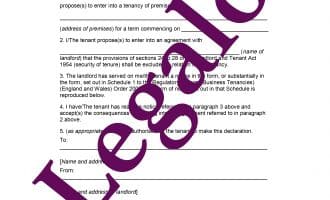Declarations and notices to contract out of LTA 1954
Our Declarations & Notices template:
- Over 300 free downloads!
- Simple to fill in
- In the standard form required by law
- Free of charge

How Does It Work?
-
1. Download
-
2. Edit
-
3. Print
-
4. Sign
This is the set of declarations and notices that you need for a commercial lease if contracting out of the security of tenure provisions under the Landlord and Tenant Act 1954 (“LTA 1954”) when putting in place:
- a new lease;
- a sub-lease; or
- an authorised guarantee agreement (or “AGA”) on assigning the remaining term of a lease. (This is only where that the parties to the lease have already contracted out from the LTA 1954.)
99% of new commercial leases are contracted out. Of the other 1%, many are not contracted out only because the landlord was not aware of the provisions.

About the Declarations and Notices
They are in the statutory form for the declarations and notices, so you should not change them. Therefore, just complete them as appropriate.
This is one of our most popular templates, with over 300 downloaded!
They are free of charge. If you download our commercial lease, sub-lease or authorised guarantee agreement, they come with these templates as a free add-on.
Contracting out of the “security of tenure” provisions of the 1954 Act
An agreement disapplying the security of tenure provisions won’t be valid unless the parties follow the correct procedure. This is from the Regulatory Reform (Business Tenancies) (England and Wales) Order 2003 (the “RRO 2003”). The RRO 2003 allows contracting out after following one of 2 procedures:
- a “statutory declaration procedure” requires that the landlord serves a “warning notice” on the proposed tenant. However, you can do this less than 14 days before the parties sign and exchange the agreement. The tenant must then complete a statutory declaration and send it to the landlord, again doing this before the parties sign and exchange the lease agreement.
- the “simple declaration procedure” or “advance notice procedure” requires the landlord to serve a warning notice at least 14 days before the parties sign and exchange the lease (or agreement for lease). The tenant must then complete a simple declaration and send it to the landlord, again doing this before the parties sign and exchange the lease (or agreement for lease).
Contracting out of the security of tenure provisions will only be valid if you follow one of these procedures correctly. Our declarations and notices template covers both situations.
When to Contract out of Security of Tenure
If you want to contract out successfully, you must follow this procedure before the parties sign the agreement. More precisely, you do this before the tenant is contractually bound to enter into the agreement. So you must follow the right process in full, before any of the following happen:
- before completion of a lease or completion of the renewal of a lease.
- before completion of an agreement for lease.
- a tenant’s going into occupation of the property before completing on the lease.
- on assigning a lease to another tenant, before completion of a guarantee or authorised guarantee agreement (AGA), if the guarantee or AGA allow the landlord to require the guarantor to take a new lease of the property in the future, e.g. if the new tenant defaults on the lease.
- where you have entered into a lease containing an option for the tenant to renew the lease, you also need to contract out again before completion of the tenant’s option to renew. (This applies only if you had properly contracted out of the original lease.)
Form of words for the Declarations and Notices
As noted above, there are 2 alternative procedures to follow: (1) the statutory declaration or (2) the simple declaration. Use the appropriate one of the 2 declarations and notices in this downloadable template.
Do not alter the wording of those statutory declarations and notices, other than by completing them as appropriate. You should not alter them, as they are the government-approved wording which works for the purposes of the LTA 1954.
Other Resources
If you need the full batch of documents for the assignment of a lease, we offer 20% off when you buy them all at the same time using our discount package – click here for more details.
When you need the full batch of documents for the sub-letting of a lease, we offer 20% off when you buy them all at the same time using our discount package – click here for more details.
If you would like to see our other commercial property templates, click on the link.

FAQs on Declarations and Notices to Contract Out of LTA 1954
Below, we have answered the top questions from the Internet on these declarations and notices for contracting out.
What is the LTA 1954?
The Landlord and Tenant Act 1954 (LTA 1954) is a UK law that regulates the rights and obligations of landlords and tenants of commercial properties. It provides tenants with security of tenure, allowing them to renew leases and remain in the premises. Landlords and tenants can agree to exclude certain provisions of the Act through “declarations and notices to contract out”. This legislation aims to balance the interests of both parties, while ensuring a degree of protection and predictability in commercial tenancy arrangements.
What is Section 38A of the LTA 1954?
Section 38A of the Landlord and Tenant Act 1954 (LTA 1954) in the UK relates to the exclusion of security of tenure rights for business tenancies. This provision allows landlords and tenants to contract out of the LTA 1954’s protection against lease termination. To do this, they must follow a specific procedure using statutory declarations and notices. Section 38A provisions enable greater flexibility in lease arrangements by waiving the tenant’s right to automatic lease renewal, subject to compliance with legal requirements.
What is a lease contracted out of Part 2 of the LTA 1954?
A lease contracted out of Part 2 of the Landlord and Tenant Act 1954 (LTA 1954) is an agreement where the landlord and tenant intentionally exclude the statutory protections and rights provided under Part 2 of the LTA 1954. Part 2 governs lease renewals and security of tenure for business tenancies. In 99% of commercial leases, as landlords do not like these provisions, they ask the tenant to waive these protections. The parties formalise this process through a Section 38A declaration and notice.
What is excluded from the 1954 Act lease?
A lease excluded from the Landlord and Tenant Act 1954 (LTA 1954) means that it does not benefit from the statutory right of renewal of the lease provided by the Act.
Why contract out of the Landlord and Tenant Act 1954?
Landlords and tenants may choose to contract out of the Landlord and Tenant Act 1954 for various reasons. To do so, you would use the declarations and notices you can find on this page. Contracting out provides the landlord with greater flexibility and control over lease terms, such as rent negotiations, lease duration, and property use. It allows them to create lease agreements that better suit their specific needs. However, it is essential to understand that contracting out of the LTA 1954 also means the tenant’s relinquishing the statutory protections and rights it offers. However, often landlords do not offer a choice and they oblige the tenant to contract out in 99% of commercial leases.
How do you contract out of the LTA 1954?
To contract out of the “right to renew” provisions in the Landlord and Tenant Act 1954 in the UK, the tenant must sign a declaration to agree to contract out of the right to renew the lease when it expires. The landlord usually prepares this declaration and sends it to the tenant to sign, with a notice in the statutory form about what it means. The declaration and notice must comply with legal requirements, including a “warning notice”. By following this process, the parties can exclude the right to renew provided by the LTA 1954. Legalo’s declarations and notices help you to do this.
The declaration comes in two alternative forms:
- a simple declaration that the tenant signs on its own if it has been given 14 days’ notice of this before the lease is due to start; or
- a “statutory declaration” that the tenant signs in front of a solicitor, etc if it has been given less than 14 days’ notice of this before the lease is due to start.
What is a notice under LTA 1954?
In the context of the parties contracting out of the right to renew the lease on expiry, a notice under LTA 1954 is a formal written communication that a landlord or tenant must provide to trigger specific provisions of the Act. It must be in the statutory form. Also the landlord must send it to the tenant before the parties sign the lease.
Does a simple declaration need to be signed?
Yes, the tenant needs to sign a simple declaration for it to be legally valid. In most cases, signatures serve as evidence of intent and agreement between the parties involved. However, the method of signing, whether it’s physical or electronic, can vary depending on legal requirements and the specific agreement.
Can a simple declaration be signed electronically?
These declarations and notices include a version for a “simple declaration”. A tenant can typically sign a simple declaration (the one the tenant uses with 14 days’ notice from the landlord) electronically if:
- both parties agree to use electronic signatures; and
- it complies with the requirements of the Electronic Communications Act 2000 and the Electronic Signatures Regulations 2002.
Does LTA 1954 apply to long leases?
The Landlord and Tenant Act 1954 (LTA 1954) in the UK does not apply to long residential leases. It primarily focuses on regulating business tenancies with a duration of at least 6 months and a fixed term. Different legal provisions govern long residential leases. They do not provide residential tenants with any statutory rights for lease renewal (security of tenure) as business tenancies do under the LTA 1954.
What is Section 37 of the 1954 Act?
Section 37 of the Landlord and Tenant Act 1954 (LTA 1954) in the UK is a right to compensation for the tenant if:
- the parties have not contracted out of the right of the tenant to renew the lease; and
- the lease cannot effectively be renewed.
As 99% of commercial leases are contracted out of the right to renew, this compensation provision rarely gets used.
What is a Section 25 notice?
If the landlord does not terminate a commercial lease under the LTA 1954 by a notice under this section, then it rolls on month-to-month on the same terms and rent as before. The landlord should serve the section 25 notice between 6 and 12 months before the lease is due to terminate. It should state whether the landlord will offer a new lease (but perhaps on a higher rent). This notice triggers lease renewal negotiations, outlining the landlord’s intentions and conditions for the lease. The notice must be in one of two forms:
- A friendly notice – this terminates the lease and states that the landlord offers a new lease, setting out the terms the landlord proposes, e.g. new level of rent; or
- A hostile notice – this also terminates the lease, but it states the landlord is not willing to grant a new lease and states the reason for this (which must fit in the limited range of grounds the LTA 1954 permits).
This is only a very brief summary of the section 25 notice procedure. The landlord must take care over serving it, which is outside the scope of this webpage.
What is a Section 26 notice?
A Section 26 notice is a tenant’s request for a renewed lease under the LTA 1954. As with the section 25 notice, the tenant must serve it correctly.



